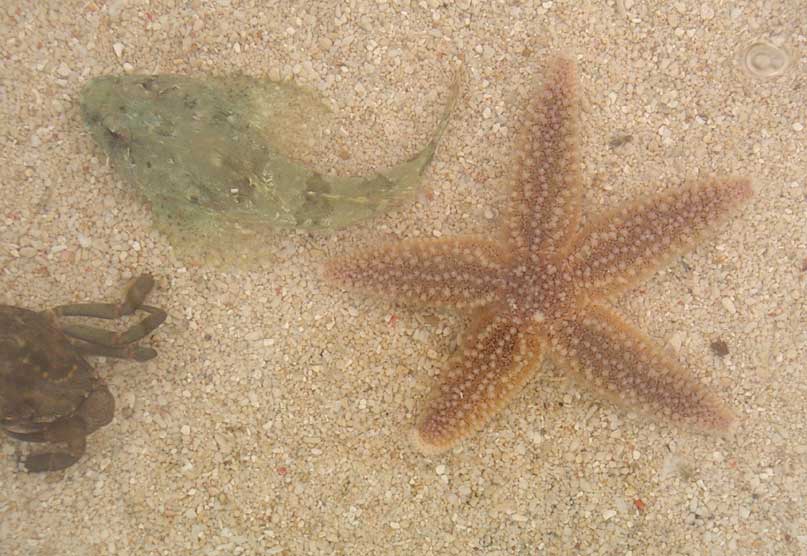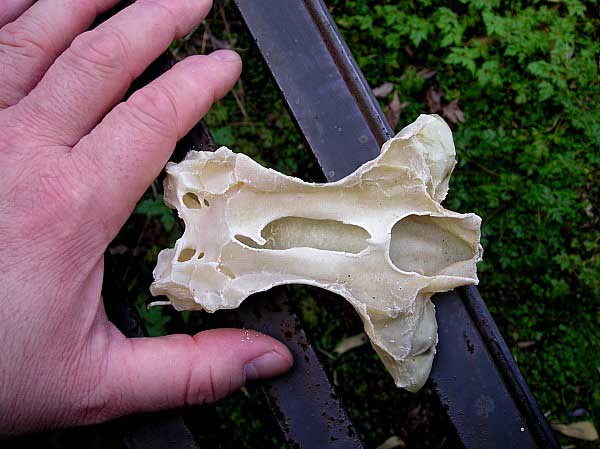 |
|
|
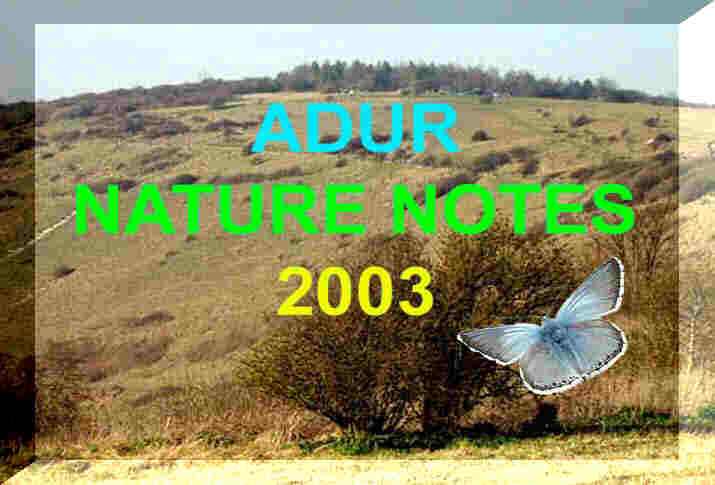 |
|
(ADUR VALLEY & DOWNS) |
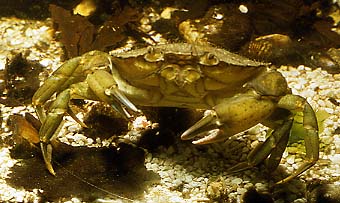 |

|
|
KINGSTON BEACH |
| Coastal Fringe |
| Chalk Downs |
| Intertidal (Seashore) |
| River Adur Estuary |
| River Adur Flood Plain |
| Sea (off Sussex) |
| Town & Gardens |
| Widewater Lagoon |
| ADUR NATURE NOTES |
| Lancing Beach |
| Kingston Buci Beach |
|
|
Seashore: Southwick to Worthing, including Shoreham-by-Sea and Lancing
- Most of Shoreham Beach is
shingle giving way to sand which is visible at low tide. Groynes prevent
longshore
drift from the west.
In the entrance to Shoreham Harbour, there are artificial rocky* shores at Kingston Beach near the Lighthouse, and at the Old Fort beach on the other side of the River Adur. (* Larvikite, a type of syenite). These new rock groynes have now been extended the full length of Shoreham Beach and as far as Lancing Beach Green (May 2003).

Edible Prawn
- At Kingston
Beach there are extensive mussel beds, with
lots of periwinkles, although a spate of over-collection
during the 1980s decimated the beds and Serrated Wrack has now established
itself, because of the reduction of the grazing molluscs.
Shore Crabs are particularly abundant at Kingston because it is the entrance to the Adur Estuary.
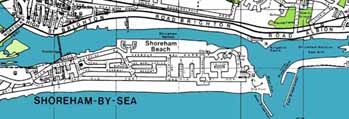
WILDLIFE REPORTS
EMail
Address for sending in wildlife reports from the lower Adur valley
Only
a selection will be included and only reports with the name of the reporter
WILDLIFE REPORTS10 December 2005
At low tide on the sand on the beach by Widewater, two Oystercatchers and handful of Common Gulls were noted as nothing unusual with a score or more omnipresent Black-headed Gulls.9 September 2005
The sunset (7:15 pm) on a exceptionally low equinoctial spring tide on Lancing Green beach, was a thin ribbon of red sky that outlined Worthing Pier three miles to the west. There was nothing really noteworthy on the shore, but there were two Small-headed Clingfish, Apletodon dentatus spotted.
Lancing Beach 200526 July 2005
A low tide visit to the seashore littered with rocks just west of the Brooklands waste pipe produced little variety. Snakelocks Anemones, Anemonia viridis, were common (100+) but other than that there were a dozen Squat Lobsters, Galathea squamifera, and the usual common crabs and other crustaceans: frequent Hairy Crabs, Long-clawed Porcelain Crabs and prawns, with one small and soft-shelled Edible Crab were seen.13 June 2005
Hundreds of cuttlebones of the Common Cuttlefish, Sepia officinalis, are washed up on the strandline along the shore as is normal in June when the adults die after spawning. In the shallow sea on a neap low tide, the push-net off Lancing Beach (off Golden Sands Caravan Park) failed to locate a single shrimp in over thirty minutes. The sand flats were barren except for an adult Weever, Echiichthys vipera, a soft recently moulted Spiny Spider Crab, Maja squinado, and one Vernal Crab, Liocarcinus vernalis.
BMLSS Crabs of the Seashore and Shallow Seas11 June 2005
Just one shrimp in the push-net off Southwick Beach with a lot of weed. A small Dover Sole, Solea solea, was captured as well as over half a dozen Vernal Crabs, Liocarcinus vernalis.Report by Peter Talbot-Elsden
4 June 2005. 10:00 am - 4:00 pm
Adur World Oceans Day
Venue: Coronation Green, New Shoreham
Adur Festival Event
Despite the overcast day and the near gales that battered the marquee, Adur World Oceans Day 2005 was a success with live animal displays of lobsters, crabs, aquarium displays of sandy shore and rocky shore fauna, the simulated rock pool, marine life photographs (all by the British Marine Life Study Society), the dolphin exhibit (Sea Watch Foundation and helpers), the Sussex Coastal Watch Project (Dee Christensen), strandline touch tables (West Sussex County Council Rural Strategy Unit), vegetated shingle of Shoreham Beach and Widewater Lagoon (Dave and Marion Wood) and the table of the Sussex Ornithological Society (Audrey Wende, with the photograph of the Gull-billed Tern in company of a Black-headed Gull, taken by Stanley Allen of the Shoreham & District Ornithological Society.)
The attendance was greater than last year as well and there was a continual stream of visitors for six hours.
The exhibition was about the animals as well as people
Representatives:
British Marine Life Study Society: Len Nevell helped by Marc Abraham (Priory
Emergency Treatment Service, PETS), Andy Horton, Peter Talbot-Elsden, Ray, Jan and Katherine Hamblett and Hannah Luff.
Sea Watch Foundation: Steve Savage and his daughter Amber, with helpers including Marc Baldwin (independent).
WSCC Rural Strategy Unit: John Knight and Kathy Eels.
Administration assistance: Natalie Brahma-Pearl (Adur District Council and Adur Festival), Neil Mitchell (WSCC Rural Strategy Unit), David Steadman (Shoreham Town Partnership).World Oceans Day web page
Adur World Oceans Day 2005 Picture Portfolio (by Ray Hamblett)
Report with More Images
28 May 2005
It was blowing a Gale Force 7 and the fauna was very limited on the shore by the Half Brick, east Worthing. A very long worm in a chalk rock was noticed when it would have overlooked if the marine life had been more prevalent. Five Butterfish, Pholis gunnellus, hid under the few rocks available for turning.
BMLSS Rockpooling25 May 2005
Shrimping (push-net in the shallows in the sea off Widewater) continued the poor results with so much weed, after the two days of strong breezes, that shrimping was severely hampered. Not a single Brown Shrimp, Crangon, was caught. A small Brill (a flatfish), Scophthalmus rhombus, was discovered floundering amongst the weed and an small Solenette, Buglossidium luteum, that escaped the net, with a dozen of the South-clawed Hermit Crab, Diogenes pugilator, and one of the swimming crabs, the Vernal Crab, Liocarcinus vernalis.
Lancing Beach
BMLSS Crabs
Vernal Crab
Liocarcinus vernalisVernal Crab
Liocarcinus vernalis23 May 2005
The exceptionally poor rockpooling season continues. The unusual sea anemone Sagartiogeton undatus was seen at mid-tide level on Kingston Beach. Later a small Daisy Anemone, Cereus pedunculatus, was discovered in the home aquarium, and it was probably introduced with a cockle. This is another sea anemone that is unusual and has not been recorded more than once or twice (if at all) on this estuarine shore. It is southern species that occasionally occurs on Worthing beach.
BMLSS Sea Anemones25 April 2005
The sea defence work had closed off access to the best beach by Lancing Beach Green. The low spring tide by the Half Brick uncovered Sea Squirt covered rocks but very little of interest. Snakelocks Anemones, Anemonia viridis, were very frequently seen (over 50) and one Squat Lobster, Galathea squamifera, plus a few common species like a damaged Hairy Crab Pilumnus hirtellus, and the sea anemone Sagartia troglodytes. A small flock of less than half a dozen Sanderlings whizzed just over the surface of the sea and shore. Generally, extremely disappointing.24 April 2005
Early morning shrimping at Southwick beach was extremly poor with only 17 Brown Shrimps caught push-netting in two hours.Report by Peter Talbot-Elsden
8 April 2005
Part of a fish skeleton was discovered on the strandline on Shoreham Beach, Sussex, as shown in the photograph. There were at least half a dozen of these skulls of various sizes.
The skeleton has not been positively identified, but the best guess is that it is a skull of the Lesser Spotted Dogfish, Scyliorhinus canicula.
Report and Photographs by Dave Mason
2 May 2005
A Solenette, Buglossidium luteum, and a Plaice in the shrimp push-net off Southwick, but there were only ten Brown Shrimps on the low neaps. This is a very poor shrimping return for April or May. However, these two fish have not been knowingly caught before whilst shrimping or rockpooling, so this was a successful outing.28 March 2005
There was petrol in the sea that completely marred a dawn shrimping session on Southwick beach the low spring Easter Monday tide. The smell was worse than the visual evidence.Report by Peter Talbot-ElsdenNB: This is probably petrol from the holidaymaker's boats that floats on the surface in an oily film in the Shoreham Harbour canal and is pumped out on the high spring tides. It has occured before. It it usually disperses in a day or two.23 February 2004
Twenty Cormorants were counted standing on the groynes on east Worthing beach (near Brooklands). These numbers never seem to change much over the years, the most I have counted was 23 a few years ago. The tide was in. At least one of the Cormorants had a pronounced grey breast and under wings. I did not have my binoculars with me at the time of observation, so I could not see the details, but this grey was very clear at a distance. This bird was on a subsidiary groyne perch and may have been an immature bird?
Rockpooling
Page
Zonation
on the Shore
Longshore Drift
Longshore drift occurs as a result of wave action. Propelled by the dominant south-west winds1 the wave (the swash) hits the shingle beach and moves the pebbles obliquely up the shore and the backwash returns the pebble at right-angles, the following waves repeating the process so that the pebbles gradually move along the shore. The larger pebbles are to be found higher up the beach as the swash is more powerful than the backwash. On Shoreham Beach the Environmental Agency interfere with the natural process by moving large amounts of shingle back to where they were washed away from, to protect the housing developments on the foreshore.
1The
prevailing winds over Britain are from the south-west. These propel the
waves on to the shore on both sides of the English Channel. However, on
other coasts the prevailing winds blow out to the sea and the dominant
waves that crash on to the shore come from other directions, e.g. from
the north-east on the North Sea coasts, causing longshore drift from north
to south.
Local Wildlife Links (SE England)
Adur
Valley Nature 2005
Adur
Valley Wildlife
Carmarthen
Bay Saltmarsh SAC
Dungeness,
Kent, England
Lancing,
Beach Green & the Shingle Beach (Ray Hamblett)
Orford
Ness: Coastal Ecology of a Shingle Bank (excellent references)
Ralph
Hollins Nature Pages (Chichester Harbour area)
Rye
Harbour Nature Reserve
Rockpooling
Page
Seashore
Page
Shingle
Coast (Coastal Fringe of Shoreham Beach)
Shingle
Discussion Group
Shoreham-by-Sea
Wildlife Page
Sussex
Wildlife Web Sites
Tides
Wildlife
& Conservation Links (West Sussex)
World
Oceans Day 2002
|
|
|
|
|










